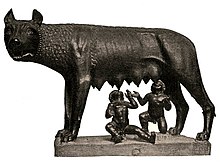|
Constantine I ‘The Great’- Roman Emperor: 307-337 A.D. –
ROME CITY COMMEMORATIVE
Bronze AE3 17mm (2.68 grams) Thessalonica mint: 330-335 A.D.
Reference: RIC 229 (VII, Thessalonica)
VRBS ROMA, helmeted, mantled bust of Roma left.
She-wolf standing left suckling Romulus and Remus, two stars above,
Θ on she wolf’s back,
SMTSЄ in exergue.
* Numismatic Note: Interesting to note the use of the Greek letter
Θ, theta for the first letter of Thessalonica in
Greek occurring only on the coins from this mint.
You are bidding on the exact item pictured,
provided with a Certificate of Authenticity and Lifetime Guarantee of
Authenticity.
Romulus and Remus are Rome’s twin
founders
in its traditional
foundation myth
. They are descendants of the Trojan prince and refugee
Aeneas
, and are
fathered by the god
Mars
or the demi-god Hercules
on a royal
Vestal Virgin
,
Rhea
Silvia
, whose uncle exposes them to die in the wild. They are found by a
she-wolf who suckles and cares for them. The twins are eventually restored to
their regal birthright, acquire many followers and decide to found a new city.

Romulus
wishes to build the new city on the Palatine Hill; Remus prefers the Aventine
Hill.
They agree to determine the site through augury. Romulus appears to receive the
more favourable signs but each claims the results in his favour. In the disputes
that follow, Remus is killed.
Ovid has Romulus
invent the festival of
Lemuria
to appease Remus’ resentful ghost.
Romulus names the new city
Rome, after
himself, and goes on to create the
Roman Legions
and the
Roman
Senate
. He adds citizens to his new city by abducting the women of the
neighboring Sabine
tribes, which results in the combination of Sabines and Romans as one Roman
people. Rome rapidly expands to become a dominant force, due to divine favour
and the inspired administrative, military and political leadership of Romulus.
In later life Romulus becomes increasingly autocratic, disappears in mysterious
circumstances and is deified as the god
Quirinus
,
the divine persona of the Roman people.
The legend of Romulus and Remus encapsulates Rome’s ideas of itself, its
origins, moral values and purpose: it has also been described as one of the most
problematic of all foundation myths. Romulus’ name is thought to be a
back-formation
from the name Rome; Remus’ is a matter for ancient and modern
speculation. The main sources for the legend approach it as history and offer an
implausibly exact chronology: Roman historians dated the city’s foundation
variously from 758 to 728 BC. Plutarch says Romulus was fifty-three at his
death; which reckoning gives the twins’ birth year as c. 771 BC. Possible
historical bases for the broad mythological narrative remain unclear and much
disputed.
Romulus and Remus are eminent among the
feral children of ancient mythography
.
Caesar Flavius Valerius
Aurelius Constantinus Augustus (27 February c. 272
– 22 May 337), commonly  known in known in
English
as Constantine I, Constantine the Great, or (among
Eastern Orthodox
, Coptic Orthodox,
Oriental Orthodox
and
Byzantine Catholic
Christians) Saint Constantine, was
Roman
emperor
from 306, and the undisputed holder of that office from 324 until
his death in 337. Best known for being the first
Christian
Roman emperor, Constantine reversed the
persecutions
of his predecessor,
Diocletian
,
and issued (with his co-emperor
Licinius
)
the Edict of Milan
in 313, which proclaimed
religious toleration
throughout the empire.
The
Byzantine
liturgical calendar, observed by the
Eastern Orthodox Church
and
Eastern Catholic Churches of Byzantine rite
, lists both Constantine and his
mother
Helena
as saints. Although he is not included in the
Latin
Church’s
list of saints, which does recognize several other Constantines as
saints, he is revered under the title “The Great” for his contributions to
Christianity
.
Constantine also transformed the ancient Greek colony of
Byzantium
into a new imperial residence,
Constantinople
, which would remain the capital of the
Byzantine Empire
for over one thousand years.
One of the great Roman emperors, Constantine rose to power when his
father Constantius Chlorus died in the year 306 while campaigning against
Scottish tribes. He later went on to defeat the rival emperor Maxentius in the
decisive battle of Milvian Bridge in 312. He is credited for several great
landmarks in history and is probably best memorialized by the city that bore his
name for hundreds of years: Constantinople. Although now renamed Istanbul, this
city was to be the seat of power for all Byzantine emperors for the next 1100
years. Constantine is also remembered as the first Roman emperor who embraced
Christianity and instituted the buildings and papal dynasty that eventually grew
into what is today the Vatican and the Pope.
The latter part of his life saw his commitment to the church rise in step
with the increasing repression against old-school paganism. He left behind
several sons who would, after his death, turn on each other and generally undo
much of the stability that Constantine had fought so hard to bring about.
|






 known in
known in


